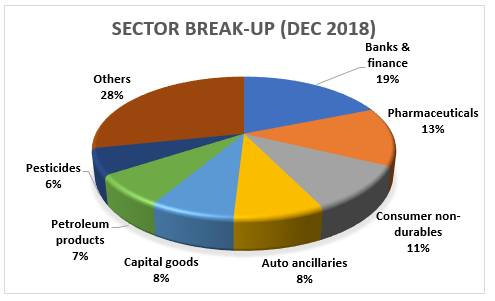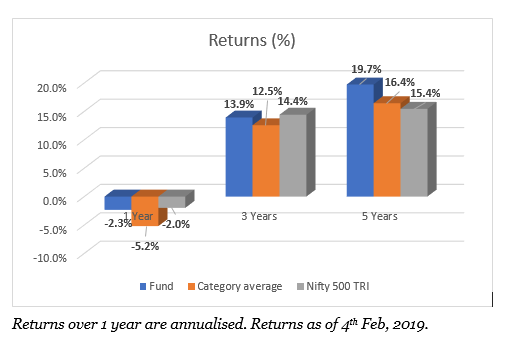An equity fund that qualifies for deductions under Section 80C of the IT Act. Why Whom Higher-risk investors looking for tax-saving investments. Haven’t invested enough to save taxes yet? Consider Aditya Birla Sun Life Tax Relief ’96, an ELSS fund that qualifies for deductions under Section 80C of the Income Tax Act. This fund averaged an annual 20% 3-year return over the past five years, above the Nifty 500 TRI’s 14.5%. Debt-based instruments such as the PPF, NSC, and post-office deposits have averaged 8-8.3% in the same period. Tax-saving funds have the capacity to deliver returns above other tax-saving options over the long term thanks to their equity nature. While the risk is higher, the payoff can also be much higher, especially in the long term. Aditya Birla Sun Life Tax Relief ’96 (ABSL Tax Relief) is an aggressive fund, with a large portion of its portfolio often in midcaps and smallcaps. This can work in its favour now, as the midcap/smallcap segments have corrected sharply over the past year. The fund is also a good addition if you already have made low-risk investments through EPF or PPF. Strategy and portfolio ABSL Tax Relief invests across market capitalisations and can get focused on mid-cap and small-caps. Earlier years have seen the fund put half or more of its portfolio in midcap and smallcap stocks. Even over the past year, the fund retained a high share in such stocks. This makes the fund among the more aggressive ones, as several tax-saving funds tend to cut sharply back on midcaps and smallcaps while the going is rough. But it also gives the fund the ability to generate higher returns; it has beaten the category average 85% of the time when rolling 3-year returns over the past 5 years. ABSL Tax Relief deviates to a large extent from the Nifty 500’s sector allocations. It combines overall sector calls with a more bottom-up approach. Its portfolio and strategy make it differentiated from other tax-saving and even multicap funds. For instance, the fund holds minimal exposure to software stocks but still picked outperformers such as TCS and Infosys. It has maintained a much lower weight to banks and financials and has been further reducing exposure here. This sets it apart from most other ELSS and multicap funds, where financials and software form heavy portfolio weights. It is among the few funds which does not have HDFC Bank in its top holdings. It is overweight on auto and auto ancillaries, though it has been paring back exposure. Direct consumer stocks through FMCG, retail, and consumer durables have for long formed a large portion of its portfolio, with stocks such as Bata India, Kansai Nerolac, P&G Hygiene, Hindustan Unilever and Gillette India delivering well. The fund balances out this consumer exposure through petroleum stocks such as Reliance Industries and capital goods stocks such as Honeywell Auto, Sundaram-Clayton, and Cummins. Exposure to industrials increased steadily from around 5% over 2017 to close to 8% now. The correction has hurt these stocks and consequently fund performance. But it offers good buying opportunities from a longer-term perspective. ABSL Tax Relief follows a buy-and-hold strategy with some stocks being a part of its portfolio for years. It takes a concentrated approach – the top 10 stocks often make up half the portfolio. This, along with the mid-and-smallcap exposure increases the risk of the portfolio. For more conservative investors, Franklin India Taxshield is the better option. Performance ABSL Tax Relief is more volatile than peers, thanks to its aggressive strategy. It is not among the best at containing downsides either. However, it holds its risk-adjusted return (measured by the Sharpe ratio) well above the category average. Its average 3-year returns over the past 5 years at 20% is well above the category’s 17% average. Its recent returns have been hurt compared to the Nifty 500 TRI. One, the higher mid-and-smallcap exposure weighed. But given the correction, it offers good opportunities at this time. Two, exposure to pharmaceuticals dragged, along with auto, industrials, cement, and select stocks. The fund has been reducing holding in some of these underperformers such as Jet Airways and Vedanta while the others are good long-term plays. Rolling 3-year returns over the past 5 years, ABSL Tax Relief has beaten the Nifty 500 TRI all the time. The average margin of such outperformance a strong 5.6 percentage points. Even in shorter 1-year periods, the fund is more consistent in beating the index than many peers. Ajay Garg is the fund’s long-time manager. It has an AUM of Rs 7,220 crore. Investments in the fund will be locked in for three years, but holding on for 5 years and longer is recommended.

Top 10 stocks (Dec. ’18)
Stock
% to net assets
Honeywell Automation
7.6%
Reliance Industries
7.2%
Gillette India
6.8%
Bayer Cropscience 6.0%
Pfizer 5.4%
GlaxoSmithKline Pharma 5.2%
Thomas Cook (India) 4.9%
HDFC 4.6%
Sundaram Clayton 4.4%
Shoppers Stop 3.5%

Other articles you may like
What
[fbcomments]







